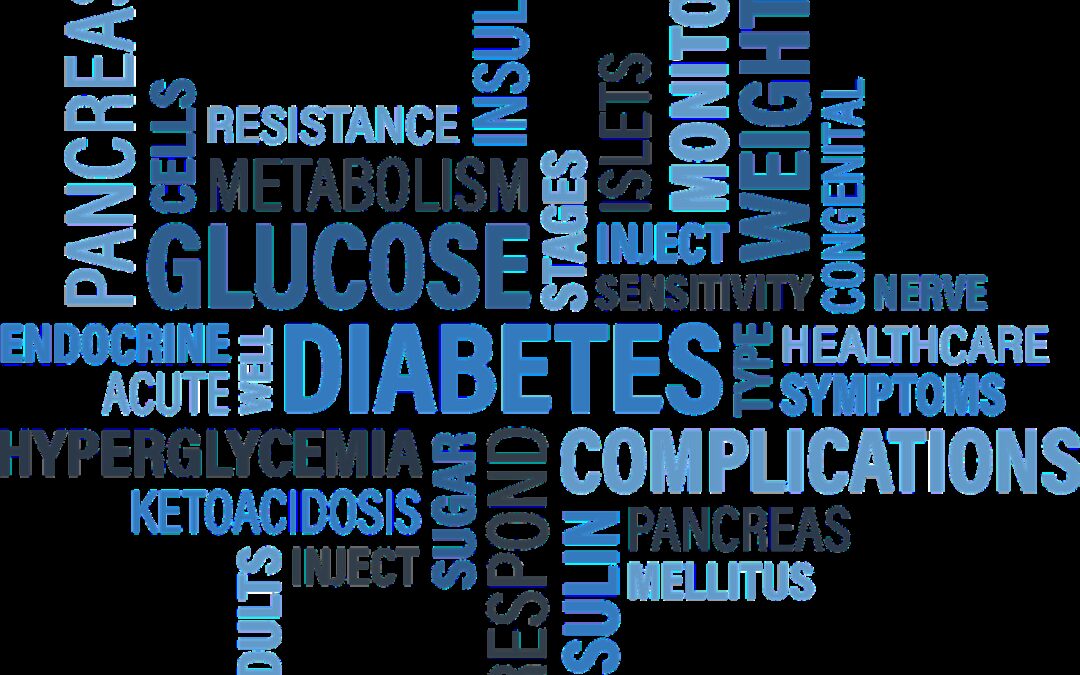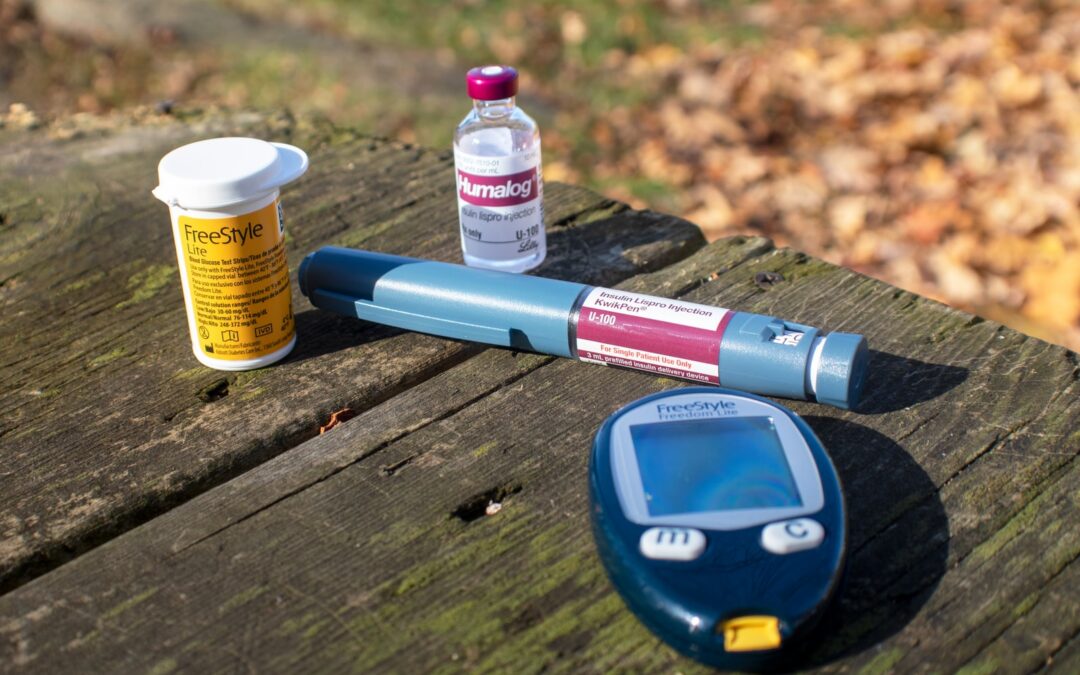
by I Dance With Diabetes | Oct 23, 2022 | Treatments
Where is diabetic technology?
OK, I’m a Star Trek fan. Even back in the original series computers have been talking to the crew. We didn’t call it Artificial Intelligence (AI), but it was clear the computer was pretty advanced. And as new seasons came and went the computer became more personable. After spending 35 years in the computer world I shouldn’t be surprised to see computers stepping in to do tasks in our world. However, it is a surprise. I don’t know if I would trust a computer get or not. What are your thoughts? Can AI provide diabetes-supporting care?
Anyhow, as the late Paul Harvey would say, “Now the rest of the story.”
Monitoring chronic disease
Chronic diseases, such as heart disease, stroke, cancer, and diabetes, have become a large cost to healthcare systems around the world over the past few decades. In fact, chronic diseases are a big part of the top ten causes of death in high-income countries. The good news is that many chronic diseases are preventable through lifestyle changes such as eating healthy, being active, and not smoking.
A very comprehensive approach to the management of chronic disease needs to cover all segments of these complex diseases. Efforts to manage conditions are required, but other resources are required to prevent disease problems. A multidisciplinary team approach is often necessary in order to provide patients with the best care possible. This team may include primary care physicians, specialists, nurses, social workers, and others who can help assess a patient’s needs and create a plan of care.

The role of data in disease management strategies is more important than ever before. Data is being used to better healthcare programs and it is a great source of evaluation and enhancements in the healthcare industry.
Data visualization has proved to be an effective way to create insights for decision-makers. One of the leading chronic diseases is diabetes.
With the global burden of disease expected to increase exponentially in the coming years, healthcare leaders are looking for insightful, evidence-based approaches to address this issue. They hope to find ways to prevent or at least slow down the progression of diseases so that patients can enjoy a better quality of life for longer.
Where technology is today
Continuous Glucose Monitoring Devices are a new field of devices powered by artificial intelligence. Automatic and real-time data on the rate of change and concentrations of blood glucose can be found in these devices. The data is used to improve predictions of hypoglycemic events and to deliver more personalized information to the user about their current state of glycemia.
Specifically, these devices use the vast amount of patient data available to provide personalized recommendations for treatment administration, greatly minimizing the risks associated with exogenous insulin administration. By tailoring administration specifically to the individual patient, these devices hope to achieve better clinical outcomes while decreasing the chance of dangerous side effects.
The artificial pancreas pilot program that applies closed-loop technology to monitor blood sugar continually and automatically adjust the amount of diabetes medicine will be offered to 1,000 patients in 2021. This program has the potential to revolutionize the management of diabetes and improve the quality of life for those who suffer from this chronic condition.

The use of artificial intelligence allows us to identify patients who are at high risk for diseases. This helps us provide them with the necessary care and treatment before the disease progresses. Artificial intelligence is a valuable tool in healthcare that can help improve patient outcomes.
In a study, a trained machine-learning model using features collected from over one million patients across multiple data sources. This model was able to predict with high accuracy the risks of cardiovascular and hyperglycemic events in people with diabetes, over the course of three years. Our results suggest that machine-learning models can be used to accurately predict risks for various diseases, making them a valuable tool for preventative healthcare.
Earlier diagnoses
This research provides valuable insights that could improve clinical outcomes for patients with diabetes. By promoting the delivery of early and personalized care, patients with diabetes can receive the treatment they need as soon as possible. This can help to improve their overall health and quality of life.
The use of artificial intelligence is being applied to detect patterns in behaviors that result in high or low blood sugar levels in people with diabetes. A large amount of data has previously been unanalyzed by continuous GLP-1, which is commonly used by people with Diabetes.
However, recent studies have shown that by using machine learning algorithms on this data, it is possible to accurately predict glucose levels up to two hours in advance. This information could be used to develop new Insulin treatments or changes in lifestyle that could help people with Diabetes better manage their condition.
In order to more accurately detect low blood sugar levels, scientists have devised an artificial intelligence system that uses data from the Continuous Glucose Monitoring (CGM) device and a non-invasive sensor. This system has the potential to provide a more reliable way of detecting low blood sugar levels, as well as being less invasive than traditional methods.
Your CGM will need to be calibrated often to make sure it is providing accurate readings. The amount of fluid in your body has to be measured with a CGM (continuous glucose monitoring) device. Many gadgets are small and use tiny sensors to capture information about your blood sugar levels. In certain cases, the sensor is placed under your skin on the belly or in the back of your arm.
The sensor on your belt will transmit information about your heart rate and other vital signs to a wireless monitor that you will clip onto your belt. The monitor will then display the information on a screen so that you can see it.

Dreaming of the future
Technology continues to make advances in the ability to provide diagnostic data. The biggest challenge will be providing the latest technology to those who need it. Diabetes is a worldwide problem. Once again the question is, “Can AI provide supporting care?”
Please join our Facebook group, Dancing with Diabetes, and the other articles on our blog pages.
Source: HOSPITALS MAGAZINE, DiabetesTimes, MD+DI

by I Dance With Diabetes | Aug 23, 2022 | Treatments
Ways of living with diabetes
You haven’t been feeling well. You’re drinking a lot of water and you’re always thirsty. Of course, with a lot of drinking water, you’re running to the bathroom more. The good news is you’re losing weight, you don’t know why, but you’re not going to complain. However, you’re awfully tried and have that fuzzy feeling of something wrong. You go to the doctor and by the symptoms you describe the doctor says, you may have type 2 diabetes. Further testing confirms your blood sugar is at the crossover between prediabetes and type 2 diabetes.
You immediately feel the doom of the diagnosis hit you like a ton of bricks. Your mind is racing with thoughts of being able to do nothing but inject yourself with needles for the rest of your life. Hopefully, your doctor recognizes your reaction and begins to comfort you, and tells you there is a lot you can do to minimize and even reverse your condition. If your doctor simply says here’s a prescription for insulin and does nothing to support you, run far away and find a doctor who cares and can guide you to a better way of dealing with your diabetes.
To get a handle on your type 2 diabetes you’ll need to find some support. You will need to make some lifestyle changes. Nothing like joining a monastery and chanting for the rest of your life. You just need to be aware that you have type 2 diabetes and be willing to be more aware of the things you eat. Depending on how high your blood sugar levels are will define how you will have to treat your condition. You reverse your condition, but you will have to monitor it for the rest of your life.
Diabetes support
You can find support from the following folks:
· An endocrinologist – a doctor focusing on the diagnosis and treatment of diseases that affect the body through hormone differences such as diabetes, hypothyroidism, hyperthyroidism, adrenal insufficiency, and menstrual disorders. Since insulin is a hormone a doctor that understands the impact of too much or too little insulin is important to have on your side.
· An ophthalmologist – An ophthalmologist is a medical doctor who specializes in the medical diagnoses and treatment of diseases and injuries that affect the eyes. They often provide primary care to patients with eye problems, provide second opinions to other physicians on their cases, and may perform corneal transplantation. Ophthalmologists differ from optometrists because they have completed four years of medical school and three years of specialized training after graduation, whereas optometrists have
· A pharmacist – A pharmacist is an expert in the field of medicines and can provide assistance to you when it comes to ensuring that your prescriptions work well with other drugs, including substances that you may be consuming recreationally. They are also able, but not obligated, to help you monitor for any negative reactions or interactions that you may have when taking medications.
· A registered dietitian – will help develop eating guidelines to provide proper nutrition. They can help you avoid the food you may be allergic to or sensitive to. Under their direction, they can help you lose weight, which is a key goal of reversing type 2 diabetes.
· A diabetes educator – the more you understand your diabetes, the more you will be able to stay a step ahead of it. By understanding what affects your blood sugar levels you will be able to react and take proper precautions to remain safe and healthy.
Different diabetes medications work in many different ways, and the side effects that they cause vary greatly. Don’t give up if you need to stop a medication or switch the type of treatment you are getting, because it is not meant for everyone. It’s also possible that you may need to try out several different medications before finding one that suits your needs; if this is the case, consult your doctor or care team who can.
Diabetes meds
There are some critical distinctions between treatments for Type 1 and Type 2 diabetes, which can be seen by the different medications taken. These include insulin therapy, metformin, and a change in diet.
Depending on the severity of your diabetes, you may have to take a meditation. There are many different meditations you could take. Here are a few of the more comment meditations that could be prescribed to you:

· Insulin – If you have been around diabetes, you have undoubtedly heard of insulin. Insulin is the hormone secreted by the pancreas to tell your cell to take in the glucose in your blood. If your doctor determines your pancreas isn’t keeping up with the demand for insulin you may have to inject yourself. There are many different types of insulin created for diabetics. This is something your doctor will determine if you need to use insulin and which one is best for your condition.
· Alpha-glucosidase inhibitors – these drugs help the body convert starchy foods, which has the effect of bringing your blood sugar levels down.
· Biguanides – these medications tell your liver how much sugar to make. It also helps manage the amount of sugar your intestines can absorb. Metformin is one of the most proper medicines prescribed.
Wrapping it all up
There’s good news and bad news. The bad news is there are many ways of living with diabetes. The good news is, that there are many ways of living with diabetes. The trick is to look at it in a way that will be a positive move in your life. Realizing the many ways to treat diabetes gives flexibility in finding what works best for you. Don’t give up, keep moving forward. This is an area that has much research going on. A greater understanding of the interaction of insulin and glucose is being done. Also, the technology to monitor and control insulin in your system is being developed.
Be patient, some day diabetes will be something that is easily managed.
Please follow our Facebook group and check out our other blog articles.

by I Dance With Diabetes | Aug 23, 2022 | Treatments
Recognizing type 2 diabetes
Type 2 diabetes is a condition that creeps up on you. In most cases, your body is slowly stressed by the condition before you really realize it. The sooner you can begin recognizing type 2 diabetes the quicker you begin to reverse the effects. Managing diabetes can be done in a variety of ways, from changing your diet to exercising and taking medication. The combination of all three works best to keep your blood sugar under control.
This is why it is important to have a regular physical check-up and blood work. This will help your doctor will figure out if you need to take medicine, which kind is right for you, and how often you should take it. It is important to note that not all medicines are safe for everyone and before taking any medication, speak with your healthcare provider.
You’ll probably deal with your disease in different ways over the course of your life. As time goes on your body changes and the method of treatment will need to change. You’ll have to switch if your medications stop working. You will have to figure out how to adjust to the different shapes and sizes of your body. Researchers are looking for a new way to treat diabetes.
People with type 2 diabetes often try medications, the first type of medicine they try is when diet and exercise alone aren’t enough to keep their blood sugar in a healthy range. There are many of them, they work in different ways. The key to living with type 2 diabetes is to look at your lifestyle. This is the first step, though it can be challenging. The habits we have developed define what our lifestyle is and changing them is not easy, but people have succeeded in controlling their blood sugar through lifestyle.

Best way to begin
Here is a list of lifestyle points that can make a difference in how you manage your diabetic condition:
- Weight loss. Many of us could be more conscious of losing weight.
- losing 5% to 10% of your current weight could do for you if you’re 200 lbs which would be equivalent to 10 to 20 pounds of your body’s weight. Other benefits would be less chance of cardiovascular and renal disease. It may also help you cut back on medications to treat diabetes, high blood pressure, and high cholesterol. The weight you lose can also lessen the chances of depression and help with improved sleep.
- Healthy diet. There is no diet that covers all the bases and will work for everyone with diabetes, but you are going to need to pay attention to carbs, fiber, fat, and salt in order to effectively manage your blood sugar levels and avoid any complications that may arise with the disease. It’s important to know how much you eat. If you’re having a medical condition, you should talk to your diabetes team or a registered dietitian to help you plan out your meals and snacks.
- Physical activity. Being active not only helps you maintain a healthy weight and reap the mental benefits of an active lifestyle, but it also helps your cells use insulin, which impacts your blood sugar levels. You have to check your blood sugar before and after exercising.
- Better sleep. Your odds of developing type 2 diabetes can go up if you don’t get enough sleep. Doctors check your average blood sugar levels over 3 months if you have raised A1c levels because of the length of time you sleep and the quality of sleep. The benefits of getting a good night’s sleep are wide-ranging and include improvements in blood sugar levels.
Hunger and fatigue
The food you eat is converted by your body into glucose, which your cells then use for energy. In order for your cells to take in the glucose, however, they need insulin. If your cells do not respond properly to the insulin that your body produces, you will have little energy and your body will not produce enough of the hormone. This can result in you feeling hungrier than usual because your body is trying to conserve energy, or more tired because you are not getting the proper nutrients.
If you find yourself needing to urinate more frequently than normal, or if you feel abnormally thirsty, these could be signs of diabetes. Diabetes is a condition in which your body does not properly process sugar, and if left untreated can lead to serious health problems. If you think you may be experiencing these symptoms, it’s important to see a doctor as soon as possible.
The average person typically urinates four to seven times within 24 hours, but people with diabetes may urinate more frequently. Normally, your body reabsorbs glucose as it passes through the kidneys. However, the body excretes more urine when blood sugar levels rise due to the fact that the kidneys can’t reabsorb all of the sugar. Increased urination can lead to dehydration, which can result in serious health problems.
When blood sugar levels rise, the kidneys are not able to reabsorb all of the sugar, causing the body to produce more urine. This increased urination causes dehydration and can lead to serious health complications.”
Since people with diabetes urinate more frequently, they may also find themselves becoming thirstier much more often as a result. This is because when you urinate, you are essentially getting rid of not just urine, but also water and electrolytes such as sodium. So, it makes sense that if you are urinating more frequently, you would need to replace those fluids by drinking more liquids and thus feeling thirstier.

It’s your turn now
These points are meant to give you a basic understanding of recognizing type 2 diabetes. Experiencing one of these points doesn’t mean you have a diabetic condition. The greater number of points mentioned above and frequency of occurrence would become grounds to check in with your health provider. The longer you wait the great chance there will be unhealthy conditions developing. If you are diagnosed with prediabetes or type 2 diabetes it is very possible to reverse the condition and move back to a normal glucose level. You’ll need to pay attention to your glucose levels, but it’s a better choice than having to rely on taking drugs you don’t need to.
Please join our Facebook group and check out our other blog articles.
Read more: WebMD

by I Dance With Diabetes | Aug 23, 2022 | Treatments
The Diabetic’s Guide to Healthy Lifestyle
This article is an overview of diabetes. Diabetes is a chronic, progressive disease that affects nearly 380 million people worldwide. It can cause serious damage to the body including harm to the heart, eyes, and kidneys. Diabetes can also cause nerve damage in the extremities and lead to poor circulation. Unfortunately, diabetes cannot be cured but it can be managed by controlling blood sugar levels through diet, exercise, and medication – which is why it’s important for people to learn about how they can reduce their glucose levels.
Diabetes is characterized by high blood sugar levels, either because of too little insulin or because cells are not sensitive to insulin. Diabetes can lead to serious health problems, including heart attack, stroke, blindness, and kidney damage.
In childhood or young adulthood, type 1 diabetes usually develops, while type 2 is more common later in life or after 40 years of age. Your body doesn’t make enough insulin if you have type 2 diabetes because it uses less of the hormone than it does for energy and later use.
Type 1 diabetes is an autoimmune disorder in which the body attacks and destroys the insulin-producing cells in the pancreas.
Excess sugar in the urine causes some symptoms, such as blurred vision, heavy appetite, and feeling hungry all the time. People with diabetes who are unable to produce it naturally need to take injections for the rest of their lives.
Type 2 diabetes is a lifestyle change
Type 2 diabetes is usually a result of lifestyle choices, such as obesity, lack of exercise, genetic predisposition, and the natural aging process.
While type 1 diabetes symptoms are definitely noticeable, type 2 diabetes symptoms are less noticeable. Being overweight, a family history of diabetes, age, and ethnicity are all risk factors for type 2 diabetes. It is important for people to be aware of their risk factors for diabetes so that they can take steps to prevent it from happening.
There are a few key symptoms that can help to identify type 2 diabetes including increased thirst, increased frequency of urination, fatigue or tiredness that doesn’t go away even with rest, blurry vision, or other vision problems such as floaters or blurred vision.
People with type 2 diabetes make their own insulin, which comes from their pancreas cells. Insulin is a hormone that is produced by cells in the pancreas. The body’s cells contain blood sugar and can be used as fuel for energy. Short-acting and long-acting are the two types of insulin. Short-acting and long-acting drugs work the same way, except that the short-acting ones last 15 minutes and the long-acting one lasts for up to 24 hours. People with Type 2 Diabetes can be treated with diet and exercise if they keep their blood sugar under control.
Diabetes medications usually have few serious side effects, but may cause unpleasant symptoms like nausea, vomiting, stomach pain, diarrhea, or constipation.
The risk of developing diabetes is higher for people who have one or more risk factors such as high blood sugar levels, obesity (especially if it’s related to a lack of physical activity), or a family history of diabetes.
There are many different treatments available for type 1 diabetes. Diabetes patients with type 1 are typically treated with injections of the drug.
There is only one treatment that can stop the progression of type 1 diabetes and that is injections of the diabetes drug, insulin.
One other option for managing diabetes is an insulin pump, which allows people to control their insulin throughout the day by giving themselves small doses through a device that is connected via a tube inserted into the abdomen.

Another treatment option for type 2 diabetes is the use of oral medications to help regulate your blood sugar levels. Some medications you might be prescribed are metformin, gliclazide, rosiglitazone, or pioglitazone. You may also need to visit a doctor who specializes in endocrinology and can help decide what medication would work best for you.
There are many treatment options for Type 2 Diabetes that can be used in conjunction with one another. These include healthy eating, physical activity, weight loss, and medication. Insulin therapy is a treatment option as well and it is important to note that these treatments will not cure diabetes but they can help manage it.
The goal of diabetes treatment is to get blood sugar levels back to normal and prevent complications from developing. It’s important for people with diabetes to follow a healthy diet, exercise regularly, and take their medications as prescribed.
It is very important for an individual with diabetes type 2 to always carry an ID card or wear a medical alert bracelet that identifies them as having the condition. In the event of a medical emergency, this will ensure that proper care can be administered without delay.
The research into diabetes management is ongoing as of right now. The goal is to find more cost-effective and effective ways to treat the disease.
Diabetes treatment trends
The latest trends in diabetes management research and therapeutics are:
– New treatment for type 2 diabetes,
– Diabetes prevention,
– Better treatments for type 1 diabetes and gestational diabetes,
– More accurate diagnosis of diabetes
The world is in the throes of a diabetes epidemic. Reducing the risk of developing diabetes, reducing the effects of the disease and slowing the progression of the disease are some of the latest trends in diabetes research.
A diabetes diet plan should be high in fiber and low in fat. Breakfast may include cereals with fruit, lunch may include whole-wheat bread with peanut butter and an apple, and dinner may include pasta with tomato sauce and a salad with olive oil on the side.
Exercise routine for diabetes patients should be low-impact, such as walking or swimming.
The benefits of a healthy diet and exercise routine for people with diabetes are clear. A healthy diet helps regulate blood sugar levels, and exercise can help lower blood sugar levels.
A well-balanced diet has to include carbohydrates, proteins, fats, vitamins, and minerals. The recommended intake of carbohydrates is about 45% to 60% of calories. There should be about 10% to 20% of calories from protein, and 20% to 35% from fat.
People with diabetes have to be careful about what they eat and how much they exercise. They need to follow a diabetic diet plan, which includes eating foods that are low in carbohydrates and sugar and sticking to an exercise routine for diabetes.
There are many different methods of treating diabetes with diet and exercise, including following a diabetic diet plan, sticking to an exercise routine for diabetes, and eating foods that are low in carbohydrates and sugar. This will help you manage your blood sugar levels and prevent complications that come with not managing your diabetes.
There are many different types of foods that are recommended for people with diabetes. One type is low-glycemic index foods, which cause blood sugar levels to rise more slowly when eaten. These include whole grains, beans, lentils, and vegetables such as broccoli and cauliflower. Eating these types of food will lead to lower blood sugar levels in the long term because they don’t cause a spike in insulin-like white bread or doughnuts would.
People with diabetes also need to exercise in order to improve their insulin sensitivity, because it will allow them to maintain a healthy weight and help avoid the onset of type 2 diabetes.

The most common type of oral diabetic treatment is metformin, which helps the liver produce more insulin so that it can better regulate the amount of glucose in your bloodstream.
Diabetes medications can be used to treat the disease. Different classes of diabetes drugs work in different ways. Diabetes patients who rely on insulin for the control of their blood sugar levels can reduce it by taking it after they eat and between meals.
There are many different medications that can be prescribed to help control blood sugar levels, such as oral medication, injectable medication, and insulin therapy.
Oral medications for Type 2 diabetes are typically taken once or twice a day before meals to help maintain healthy glucose levels.
The side effects of diabetic medications vary depending on the type of medication and the person taking it. They may include nausea, vomiting, diarrhea, heartburn, headache, and dizziness.
However, there are ways to prevent these reactions from happening.
Possible side effects include dizziness, difficulty breathing, wheezing, increased thirst or urination, unusual weight loss or gain, and darkening of the skin. It is advisable to talk with your doctor before taking any medication to make sure you are aware of the risks.
The side effects of diabetic medications can be difficult to deal with, but there are ways to prevent these reactions.
Diabetic medications and side effects
The most common side effects of diabetic medications are:
-Nausea
-Vomiting
-Headaches
-Dizziness
-Loss of appetite
-Blurred vision
-Excessive thirst or urination.
Insulin comes in a number of different types that are used to treat different conditions. They are classified by their onset and duration:
The two main types are human insulin and animal insulin. Human insulin, which is made from cows or pigs, can be used by people with diabetes as well as people who have an allergy to animal products.
Insulin reactions are the body’s natural reaction to insulin injection, and they vary based on the type of insulin being used. Some people may experience an allergic reaction, but others may have no reaction at all.
Side effects of insulin therapy are common among people with diabetes and include weight gain, low blood sugar, and high blood sugar levels.
Insulin reactions and side effects of insulin therapy in people with diabetes are very important topics for anyone living with diabetes.
Symptoms of an insulin reaction may include shakiness, cold sweats, nausea, vomiting, dizziness, and confusion. This can be the result of either having too much or too little insulin in their blood according to how the body is reacting to a certain scenario.
Conclusion
To live with diabetes one must be willing to actively be aware of their blood sugar and take steps to control it. You will never be cured of diabetes, but with a plan tuned to your needs, you will live a healthy life. I hope this overview of diabetes was helpful. Please join our Facebook group and check out our other blog articles.
Read more: WebMD
*****************

by I Dance With Diabetes | Aug 23, 2022 | Treatments
Great Ideas to Manage High Blood Sugar Levels
My wife loves to bake. I love to eat what she bakes. I’m eating chocolate-covered raisins as I type this article. I know there’s too much sugar in everything I eat. My glucose level at my last physical is proof of that. Hence the reason for this article. Sugar is slowly killing me. I need to cut back. This article will explore what sugar is and why our health is suffering from it.
Sugar is an addictive substance that can cause health problems. It increases the risk of diseases such as diabetes, heart disease, and cancer.
What is sugar?
Sugar is found in foods as well as plants and animals. It is used as a functional ingredient in many food and drink products. calories from sugar can be used for energy for the body.
There are two types of sugar:
1) Sucrose or table sugar – this type of sugar comprises one molecule of glucose and one molecule of fructose.
2) Lactose or milk sugar – this type of sugar is made up of one molecule each of glucose and galactose.
Sugar can be found in many different food products that we use on a daily basis. It’s used to add sweetness and increase the quality of these items. Sugar can be found in things like sugary candy, ice cream, or baked goods which are known for their high sugar content.
The sugar content of food can vary depending on the type of food and how much sugar has been added. Sugar is added to our food because we like it, but in some cases manufacturers also add it because people have come to depend on its sweetness as a flavor enhancer.
The different types of sugar
The different types of sugar include sucrose, fructose, glucose, maltose, lactose, and maltodextrin.
– Sucrose: This type of sugar is found in most foods that are high in calories such as chocolate (love those chocolate-covered raisins) and ice cream. It’s also found in fruit juice and baked goods.
– Fructose: This type of sugar is found naturally in fruits such as apples, oranges, berries, and dates.
– Glucose: This type of sugar provides energy for the cells that make up your muscles and brain cells to function properly. Foods like cereal grains, pasta, or potatoes are high in this kind of sugar because it’s a natural part of the plant’s structure.
White sugar: White sugar is the most common type of sugar, and there are two forms of it: refined white sugar and raw cane sugar. raw cane sugar is made from the juice of freshly-pressed cane, while refined white sugar comes from either beet or cane.
Brown Sugar: Brown sugars are made from molasses and white sugar. They come in either light or dark varieties, with light sugars being less sweet than dark sugars.
Honey: Honey is produced by honeybees from nectar gathered from flowers, and is a complex carbohydrate composed mainly of fructose and glucose. It has a distinctive flavor that makes it desirable as a sweetener for some foods, such as tea.
Many recipes use sugar in various forms, and it’s a key part of them. Different types of sugar can be used to cook, bake, or prepare various other food preparation tasks.
How much sugar is too much?
We all know that sugar is bad for us. How much sugar is too much? An average American consumes an excessive amount of sugar on a daily basis. The average American consumes 22 to 25 grams of sugar per day, making it about 350 calories worth of sugar.
The World Health Organization recommends that adults and children reduce their daily intake of free sugars to less than 10% of their total energy intake or no more than six teaspoons of sugar per day. The WHO says that this is not a hard limit.
The World Health Organization suggests that reducing sugar intake to below 5% or roughly 25 grams (6 teaspoons) per day would provide additional health benefits.
A reduction to this level is recommended for those who are at risk of becoming overweight, including those who feel that they are already overweight or obese, and those with an increased risk of high blood pressure, type 2 diabetes, heart disease, or dental caries.
Natural sugar is made from cane or beets, while artificial sugar is made from chemical compounds.
Artificial sugar was subsidized by the government, so it was a much cheaper alternative to natural sugar. Artificial sugars are now more expensive than natural sugars, but they are still cheaper than most other sweeteners.
Artificial sugars are made from chemicals and are often used in diet sodas, low-calorie foods, and other products. Natural sugars come from plants and animals.
Natural sugar is made up of the sugar found in fruit, honey, milk, or maple syrup. Artificial sugar is made up of high fructose corn syrup (HFCS), aspartame, and sucralose.
Natural sugars are typically found in fruits, vegetables, and dairy products. Artificial sugars can be found in many processed food items such as soft drinks, candy, baked goods, and more.

Sugar can cause a variety of health problems, including tooth decay and obesity. Sugar has also been linked to diabetes, heart disease, and even cancer.
Some people believe that there is no such thing as a healthy amount of sugar and that it should be avoided at all costs, while others argue that small amounts are necessary for good health.
A healthy amount of sugar is the amount that can be found in a piece of fruit. A healthy diet should not have more than 25 grams of sugar per day. This may sound like a lot but it really isn’t considering how much we consume on average every day. If you are trying to lose weight, then you should try to limit your intake of sugar to 10 grams per day.
The amount of sugar in food is measured in grams and the average person eats about 150-200 grams per day.
It’s true that sugar can be found in a number of healthy foods, like fruits and vegetables. But the problem is not the sugar itself, but rather the quantity of it in our diet.
It is important to know how much sugar is too much and how to know if you’re at risk for diabetes.
Excess sugar consumption can lead to weight gain, type 2 diabetes, and tooth decay.
The last thing to know about sugar is that the total number of calories you consume in a day matters more than the type of foods you eat. So if you are eating too many calories from any kind of food – even healthy ones – it could lead to weight gain and other health problems.
High fructose corn syrup has been linked to weight gain, diabetes, heart disease, and other health issues. Sugar can be addictive because it causes your brain to release dopamine which makes you feel good.
Sugar addiction is a serious problem. In fact, the majority of Americans are addicted to high fructose corn syrup. We can see how it affects our health by reading articles like “Is Sugar Really Making You Depressed?” and “How Sugar Affects Your Brain”.

A lot of people believe that the addiction to sugar is caused by the addictive properties of high fructose corn syrup. The consumption of this substance has been linked to many serious health problems such as diabetes, obesity, heart disease, and cancer.
The first step in overcoming sugar addiction is to identify the triggers that cause you to crave sugar. Some common triggers are hunger, stress, or boredom. Once you have identified these triggers, you can take steps to avoid them when they happen in your day-to-day life. For example, if you find yourself craving sugar when you get home from work, then make sure that you eat dinner before arriving home so that your body won’t be hungry when it’s time for a bedtime snack.
Sugar has been a part of the human diet for thousands of years. It is found in many foods and drinks. Sugar is also used in many processed foods and sweets, as well as some medicines.
The effects of sugar on the body depend on how much you eat, what type you eat, and your individual health. Your amount of sugar can be reduced by cutting back on sugary drinks, limiting sweets and processed foods, and eating more whole grains, fruits, vegetables, and legumes.
It is important to get the sugar intake under control. This can be achieved by limiting the consumption of sugar to 10% of your total daily caloric intake. In addition, you can try limiting your intake of refined sugars and sweeteners like high fructose corn syrup and sucrose.
We should avoid sugar as much as possible to maintain a healthy lifestyle.
Sugar is an important part of our diet, but it can be difficult to tell how much sugar we are eating.
The amount of sugar in our diet can depend on the type of food we eat or drink. Foods that are high in fat and low in fiber usually contain more sugar than foods that are high in fiber and low in fat. For example, a typical slice of cake contains 15g of sugar while a typical apple contains 5g of sugar.
Sugar is an important part of our diet for energy and for providing nutrients such as iron, calcium, and vitamin C. However, it should only make up 10% of total calorie intake per day. It’s also important to know that while fruit contains natural sugars it also contains fiber which helps slow down the release of sugar into the body.
To lower your blood sugar levels, you need to change your diet
There are many ways to lower your blood sugar levels through diet. Some of the most effective ways are eating fewer carbohydrates, eating more protein and vegetables, and eating more fiber.
If you are diagnosed with high blood sugar levels, it is essential to know how to lower them. Here are different ways you can reduce your blood sugar level by making some changes in your diet.
-Eat a low-carb diet: A low-carb diet is one of the most effective ways to reduce your blood sugar levels because it reduces the amount of glucose in your body.
-Drink water: Drinking plenty of water also helps reduce high blood sugar levels because it helps break down glycogen and prevents dehydration.
-Exercise: Regular exercise also helps lower high blood sugar levels because it increases insulin sensitivity and decreases the amount of glucose in
Being diagnosed with high blood sugar levels can be a scary experience. It is important to know the symptoms and how to lower them naturally.
A diet that is rich in fruits, vegetables, and whole grains will help you lower your blood sugar levels. Eating these foods will also help you lose weight and reduce your risk of heart disease.
To avoid sugars, you need to get rid of all processed food from your diet. This includes anything that is pre-packaged or even microwavable. Sugar can be found in many different forms and is often hiding in the most unexpected places.
One of the most important things that you can do for your health is to keep your sugar intake low. Sugars are found in many different foods and drinks, so it is important to be aware of how much sugar you are consuming.
Healthy eating is not just about what you eat, but how much you eat. Sugars are important nutrients that our body needs, but we should be mindful of the amount of sugar that we consume in our diet.
It is scientifically proven that too much sugar can be harmful to your health.
5 reasons why you should limit :
1) Added sugars can lead to weight gain.
2) Added sugars can worsen heart disease risk factors.
3) Added sugars can cause high blood pressure.
4) Added sugars can increase the risk of type 2 diabetes.
5) Added sugar consumption has been linked to cancer and dementia.
Added sugars are sugars that are added to foods or beverages during processing or preparation. Added sugars have no nutritional value and can lead to tooth decay, weight gain, and other health problems.
Cutting back on sugar is something that doesn’t happen easily overnight. It’s something that will take effort and willpower. For me, I have the luxury of being able to back away slowly. How about you?
Hope you enjoyed this article, Great Ideas to Manage High Blood Sugar Levels. Check out our other blog article.
Please join our Facebook group and check out our other blog articles.
Read more: WebMD
************************************

by I Dance With Diabetes | Aug 23, 2022 | Treatments
Diabetes and diets
When it comes to diets, my favorite diet is see food, see food and eat. As I have aged things are changing, I can’t eat like I used to, nor do I really want to. Gone are the days of eating everything that I could put on my plate. Gone are the days of going to a buffet and seeing how many plates of food I could eat. It would drive my wife crazy when I would be stacking up plates as badges of honor. Now each plate is a reminder of heartburn and indigestion. Now as I slide into prediabetes the idea of having to be more aware of what I’m eating reduces the joy of eating more to a task. This article is a journey into the various diets and how they may match up with prediabetes and type 2 diabetes needs. Diabetes and diet are becoming a way of life.
When starting this diet quest, it became obvious that there are many diets, but not every diet may line up with people with prediabetes and type 2 diabetes. I’ll select various diets and review how well you line up for people with this condition. So here we go.
It seems that when you start to explore diets and what is good the field becomes very fuzzy. Everyone wants you to try the diet plan because it’s good for you, in their opinion.
Lifestyle changes are common sense
Beginning to make this type of lifestyle change takes good old common sense. If you what to reverse the ways that got to where you are now, you just have to do it. Before looking at any diet plan there are some key points to remember, they are:
Portion size – When it comes to maintaining a healthy lifestyle, your diet is a very important aspect. It’s important to watch the portion size of what you eat, as well as be mindful of the calories and other nutritional information that you’re consuming.
We recommend cutting back on fried foods, sugary drinks, and anything salty or fatty. You should also be focusing on lots of veggies with whole grains, lean protein, low-fat dairy products, and fruit.
Your doctor or diabetes coach can help you fine-tune your diet by making it more specific to your needs. This will help to decrease the likelihood of diabetes-related complications and improve your quality of life.
Lower carbs – You don’t have to completely give up carbohydrates just because you have diabetes. If you would like to try a different diet that limits them, such as Atkins or South Beach, talk to your doctor to see if it is right for you.
State-of-the-art research on the benefits of low-carb diets for type 2 diabetes is still mixed, but a review authored by 25 leading experts in the field found that this style
of eating should be the first step in managing the disease because it can “reliably reduce high blood glucose.”
Processed food – Nowadays, we’re bombarded with a vast array of food choices. Most people choose to select the quickest, easiest, and cheapest foods that are on offer when they have the option. This means that we end up getting a diet comprised primarily of overly processed foods that are excessively high in fat.
A lot of people don’t know what “processed food” is and many don’t even realize that it is a subcategory of food. When the primary focus of one’s diet revolves around this
kind of food on a regular basis, it becomes an issue, even though occasional consumption of this food is not a big deal. One underlying problem is the fact that processed food contains ingredients like high fructose corn syrup,
As we said earlier there are many types of diets. We will review a couple here and now, but over time we will select more so you can decide which one fills your lifestyle.
A couple of diet plans
 –
–
There are many reasons why the Mediterranean diet is good for diabetes. Firstly, it is very flexible. Following a strict diet that has many forbidden foods can not only be hard to follow for an extended period of time but also make it difficult to enjoy your meals with your family.
Managing diabetes can be a difficult process, but there are many healthy options that can help. Maintaining a healthy diet, getting more exercise, and including plenty of the right foods (such as those found in the Mediterranean) that help with blood sugar control can drastically improve the process. Limiting foods that raise blood sugar levels quickly (like sugar-heavy sweets or refined grains) can also be beneficial in helping manage both weight and diabetes.
The Mediterranean diet is a wonderful choice for those with diabetes, considering its high intake of heart-healthy fats while restricting saturated fats from red meat and of course high-fat dairy. As well as the diet includes plenty of foods rich in natural antioxidants and polyphenols that help control blood sugar levels.
On top of providing a healthy diet, incorporating plenty of fiber-rich foods into your diet can help manage your blood sugar levels. Fiber-rich foods include whole legumes, grains, and fresh produce, and when digested slowly it slows down the rate at which sugar enters your bloodstream. This helps prevent blood sugar spikes by slowing down the rate at which sugar enters your bloodstream.
DASH diet plan – The DASH (Dietary Approaches to Stop Hypertension) diet is built around incorporating healthy eating habits into your lifestyle. This includes substituting whole food for processed foods to reduce the intake of sodium, sugar, and saturated fats. It also means finding a balance between lean meats and plant-based proteins to ensure that you avoid excessive consumption of animal products.
One of its points is to cut back on salt. The American Heart Association recommends that people limit their daily intake of salt to 2,300 mcg per day. It’s about half of a small amount of salt. If you want to reduce your blood pressure more, drop the amount of salt to 1,500mg, or about a third of a cup of salt.
The addition of oils rich in omega-3 fatty acids, almonds and walnut, flaxseeds/linseeds, and avocados to your diet can help you control your blood sugars and give you more energy.
DASH is not an eating plan you follow for a short period of time. It’s designed to provide lifelong nutrition for people with diabetes. To improve your health, it is important to make small changes that are sustainable. This means that you should start by reducing your sugar intake or adding more fruits and veggies to all meals. Also, spice up your meals and move away from salt it will bring more excitement to your table.
The diet provides you with the flexibility to choose how you want to begin and what steps you would like to take, as well as when. It is also important for you to remember that the diet is not a short-term solution and it does require a commitment from your end.
If you’re looking for a good place to start, you may want to explore the National Heart, Lung, and Blood Institute’s database of DASH-friendly recipes. The DASH diet is all about moderation and balance and it doesn’t matter if you’re diabetic or have high blood pressure, this eating plan can work for anyone. Find healthier alternatives to your favorite meals while still being able to manage your diabetes with the help of this database.
There is no one way to deal with diabetes. Diabetes and diet are how one deals with life. There are many ways to change your lifestyle to achieve success in lowering your blood sugar. Diet is one place to start with. We will review other lifestyle changes in future articles. Let us know what you would like to see.
Please follow our Facebook page and check out our other blog articles.
H/T: WebMD, Eating Well, Abbott























